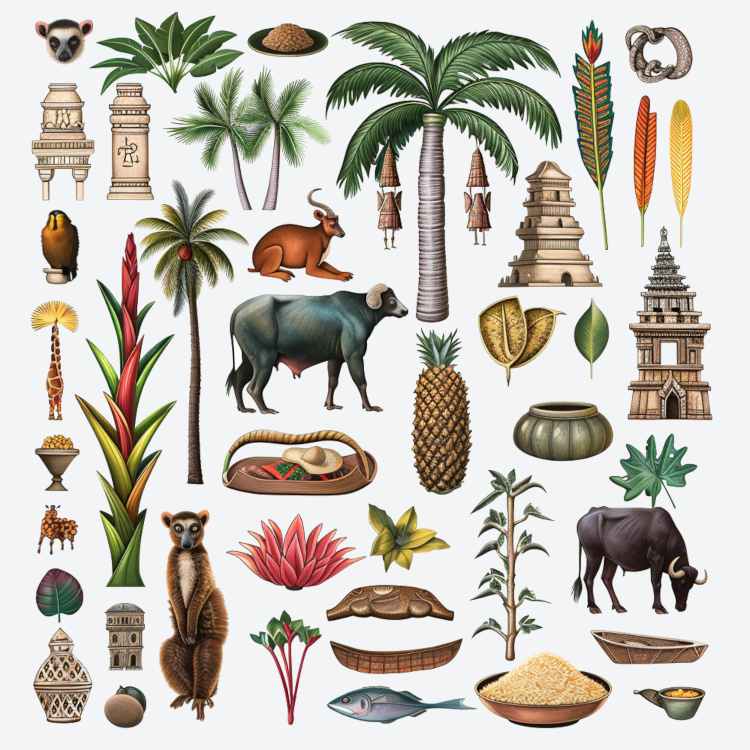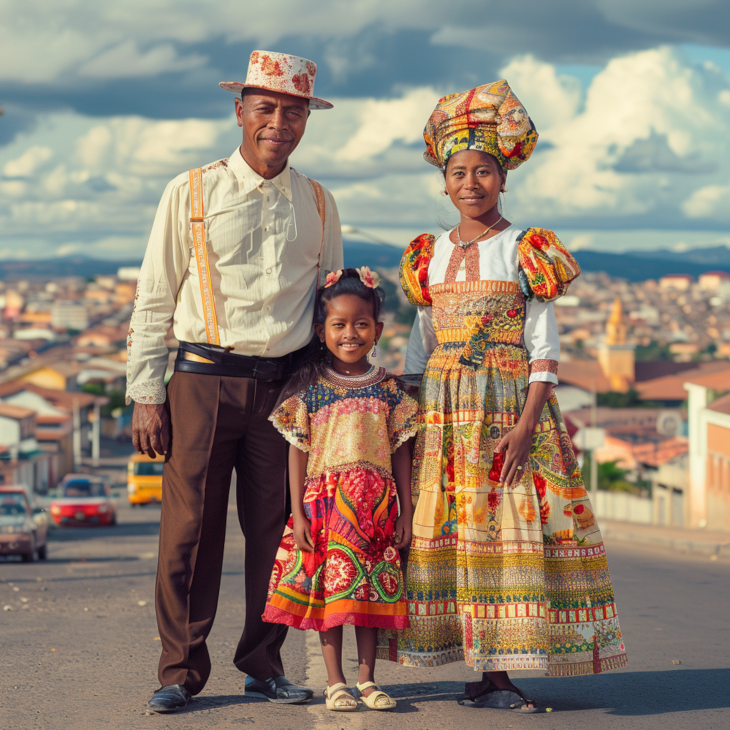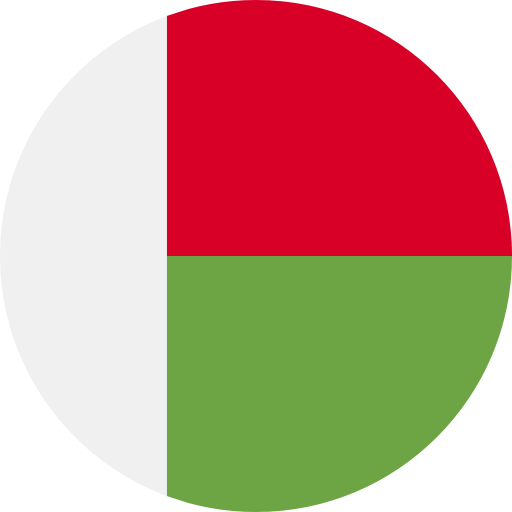About MG

Location
Madagascar is an island country located off the southeastern coast of Africa in the Indian Ocean. It is the fourth largest island in the world.
Capital
The capital city of Madagascar is Antananarivo, located in the central highlands of the island.
Population
As of the latest estimates, Madagascar has a population of approximately 27 million people.
Area
Madagascar covers a total land area of about 587,041 square kilometers (226,658 square miles).
Official Languages
The official languages of Madagascar are Malagasy and French. Malagasy is the most widely spoken language and is used in daily communication by the majority of the population.
Government
Madagascar is a semi-presidential republic with a multi-party system. The President of Madagascar is the head of state and government, while the Prime Minister assists in the administration of the country.
Independence
Madagascar gained independence from France on June 26, 1960.
Currency
The currency of Madagascar is the Malagasy Ariary (MGA).
Economy
Madagascar's economy is primarily based on agriculture, with the majority of the population engaged in subsistence farming. The country is known for its rich biodiversity and unique flora and fauna. Tourism, mining (including gemstones), and textiles also contribute to the economy.
Environment
Madagascar is renowned for its biodiversity, with a high level of endemism found in its plant and animal species. However, the country faces environmental challenges such as deforestation, habitat destruction, and loss of biodiversity due to human activities.
Culture
Malagasy culture is a blend of African, Asian, and European influences. Traditional practices, rituals, music, and dance are important aspects of Malagasy culture, often tied to spiritual beliefs and ceremonies.
Religion
The majority of the population in Madagascar practices Christianity, with a significant portion adhering to traditional indigenous beliefs and practices. There is also a minority Muslim population.
Landscapes
Madagascar is known for its diverse landscapes, including rainforests, dry deciduous forests, spiny forests, savannas, and highlands. The island is also home to unique geological formations and ecosystems.
Challenges
Madagascar faces challenges related to poverty, political instability, deforestation, environmental degradation, and natural disasters such as cyclones.

National Items of Madagascar
Lemur
Lemurs are endemic to Madagascar and symbolize the unique biodiversity and conservation efforts of the island.
Ravinala (Traveller’s Palm)
The Ravinala, or Traveller’s Palm, is a national symbol of Madagascar. It represents the island's unique flora and is featured on the national emblem.
Zebu
Zebu cattle are integral to Malagasy culture and agriculture. They symbolize wealth, sustenance, and traditional farming practices.
Baobab Tree
The Baobab tree is iconic in Madagascar and symbolizes longevity, resilience, and the unique natural beauty of the island.
Rice
Rice is a staple food in Madagascar. It symbolizes sustenance, agricultural heritage, and the importance of farming to the Malagasy people.
Vanilla
Madagascar is the world's leading producer of vanilla. It symbolizes the country's agricultural heritage, economic importance, and unique flavor profiles.
Akanjo
Akanjo is traditional Malagasy clothing, often colorful and intricately designed. It symbolizes cultural heritage, identity, and traditional fashion.
Hira Gasy
Hira Gasy is a traditional form of Malagasy music and dance, often performed at festivals and ceremonies. It symbolizes cultural heritage, artistic expression, and social traditions.
Famadihana
Famadihana, or "the turning of the bones," is a traditional funerary ritual in Madagascar. It symbolizes respect for ancestors, cultural heritage, and the importance of family ties.
Malagasy Orchid
Madagascar is home to many unique orchid species. Orchids symbolize the island’s rich biodiversity and natural beauty.
Aye-aye
The Aye-aye is a unique nocturnal lemur native to Madagascar. It symbolizes the island's unique wildlife and conservation efforts.
Ranomafana National Park
Ranomafana National Park is a significant conservation area in Madagascar. It symbolizes the country's commitment to biodiversity and natural beauty.
Ravitoto
Ravitoto is a traditional Malagasy dish made from cassava leaves and pork. It symbolizes the rich culinary heritage and traditional foods of Madagascar.
Andasibe-Mantadia National Park
Andasibe-Mantadia National Park is known for its diverse wildlife, including the Indri lemur. It symbolizes conservation efforts and natural beauty.
Tromba
Tromba is a traditional Malagasy spirit possession ceremony. It symbolizes spiritual beliefs, cultural heritage, and traditional practices.
Sakalava Canoe
The Sakalava canoe is used by the coastal Sakalava people for fishing and transportation. It symbolizes maritime heritage, traditional craftsmanship, and the importance of the sea.
Mahafaly Tombs
Mahafaly tombs are elaborately decorated burial sites in southern Madagascar. They symbolize cultural heritage, artistic expression, and respect for the deceased.
Red Tsingy
The Red Tsingy formations are unique sandstone structures found in Madagascar. They symbolize the island's geological diversity and natural wonders.
Sambatra
Sambatra is a traditional circumcision ceremony practiced by the Antambahoaka people. It symbolizes cultural rites of passage, social cohesion, and traditional values.

This anthem reflects the love, pride, and loyalty of the Malagasy people to their country and emphasizes the importance of freedom, unity, and protection of the nation.
The national anthem of Madagascar is called "Ry Tanindrazanay Malala ô!" in Malagasy, which translates to "Oh, Our Beloved Fatherland!" in English. Here are the lyrics in Malagasy along with an English translation:
Ry tanindrazanay malala ô!
Ny fahalalahanao tsy mba dô !
Ny fitsaranao foana tsy mba ho hitsiny,
Fa ho anao doria tokoa izahay
Hoy ny taranak'Iarivo :
Fa ho anao, ho anao ho anao, doria tokoa izahay.
Ry tanindrazanay malala ô!
Ny fahalalahanao aty mba dô!
Ny fitsaranao foana aty mba ho hitsiny,
Fa ho anao doria tokoa izahay
Hoy ny taranak'Iarivo:
Fa ho anao, ho anao ho anao, doria tokoa izahay.
Ry tanindrazanay malala ô!
Ny fahalalahanao dinihinao!
Ny fitsaranao foana dinihinao!
Fa ho anao doria tokoa izahay
Hoy ny taranak'Iarivo:
Fa ho anao, ho anao ho anao, doria tokoa izahay.
Oh, Our Beloved Fatherland!
Your children do not wish to be slaves.
Nowhere else in the world do we find a sweet liberty.
Oh, Our Beloved Fatherland, oh!
So we love, honor, and defend you,
Always remain your worthy children.
Oh, Our Beloved Fatherland!
To your sons who are called to lead you,
We wish that you would bless them,
And that you would keep them faithful,
Hoy ny taranak'Iarivo:
So we love, honor, and defend you,
Always remain your worthy children.
Oh, Our Beloved Fatherland!
Grant your blessing to our country,
Blow away the cloud of the people who plot against you,
Oh, Our Beloved Fatherland, oh!
So we love, honor, and defend you,
Always remain your worthy children.


